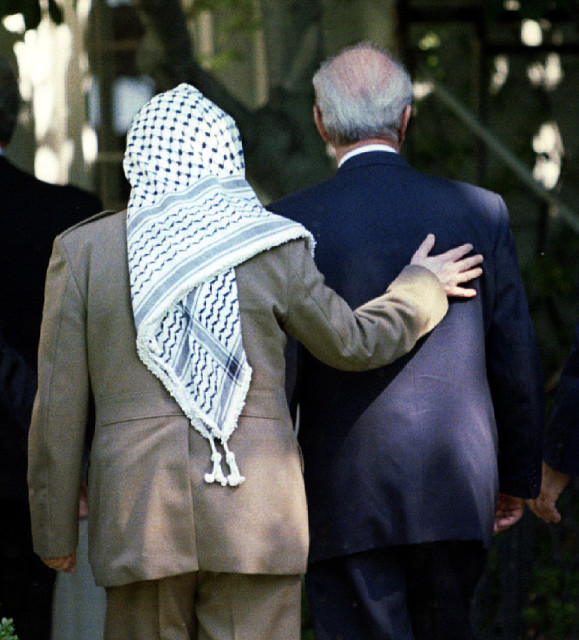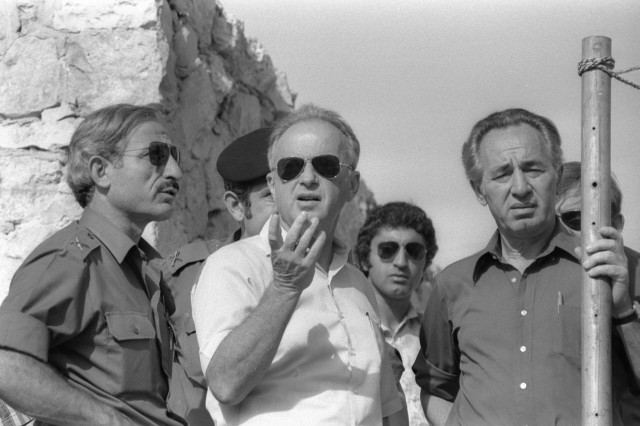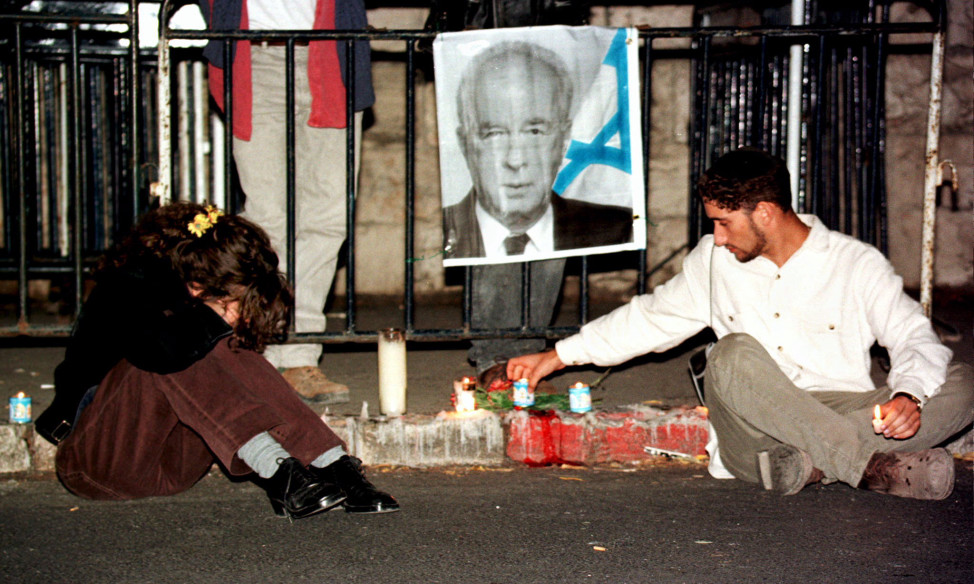Shot in the Heart
Dexter Filkins – The New Yorker
…the killing of Yitzhak Rabin, the Israeli Prime Minister, in 1995, by Yigal Amir, an Israeli extremist, bids to be one of history’s most effective political murders.
Two years earlier, Rabin, setting aside a lifetime of enmity, appeared on the White House lawn with Yasir Arafat, the leader of the Palestine Liberation Organization and a former terrorist, to agree to a framework for limited Palestinian self-rule in the occupied territories; the next year, somewhat less painfully, he returned to the White House, with Jordan’s King Hussein, to officially end a forty-six-year state of war.

PLO chairman Yasser Arafat (l) puts his arm around Israeli Prime Minister Yitzhak Rabin as they enter the White House on Sept. 28, 1995 prior to the signing of an Israeli-PLO accord. (Reuters)
Within months of Rabin’s death, Benjamin Netanyahu was the new Prime Minister and the prospects for a wider-ranging peace in the Middle East, which had seemed in Rabin’s grasp, were dead, too.
Twenty years later, Netanyahu is into his fourth term, and the kind of peace that Rabin envisaged seems more distant than ever.
Tragic Parallels in the Yitzak Rabin and Abraham Lincoln Assassinations
Dan Ephron – The Washington Post
Both countries choose a leader in a fractious election, and in both countries these leaders set out to resolve the core issue according to the vision of only a section of his country — the section that voted for him. So it goes in democracies.
Yigal Amir is led into a Tel Aviv court on Nov. 6, 1995 where he confessed to killing Prime Minister Yitzhak Rabin. (Reuters)
And that’s where the stories diverge. Lincoln dies, but his legacy — preserving the Union and doing away with slavery — remains intact. The assassination goes down as a failure….
Rabin dies as well. But his murder sets off a chain reaction that shifts power in Israel from the pragmatists to the ideologues and ultimately guts his peace process. As assassinations go, it stands as one of the most successful in history….Rabin’s leadership was unique… and Amir knew it. In his confession, he said that he killed Rabin because his record in war made him a singularly effective advocate for peace. Amir’s brother, Hagai, who helped plot the murder, predicted Israel would be a different country without Rabin.
Did Rabin Assassination Kill the Best Chance for Peace?
Jeremy Bowen – BBC
Yitzhak Rabin was the vital Israeli if peace was to be made. He was the man Israelis trusted most with their security.
Rabin had been a leading commander in Israel’s independence war in 1948-49. In 1967, as chief of staff, Israel’s most senior general, he led their armed forces to their most decisive victory over their Arab enemies….

Israel’s Defense Minister Shimon Peres (R) stands next to Prime Minister Yitzhak Rabin during a visit to the ruins of a synagogue in the West Bank City of Hebron Oct. 15, 1976 in this photo released by the Israeli government. (Reuters)
Once the Oslo peace process started, he put his weight behind it in the Knesset, Israel’s parliament, and internationally. This was a typical quote, from a speech in 1993:
“I, serial number 30743, Lieutenant General in reserves Yitzhak Rabin, a soldier in the Israel Defense Forces and in the army of peace, I, who have sent armies into fire and soldiers to their death, say today: We sail onto a war which has no casualties, no wounded, no blood nor suffering. It is the only war which is a pleasure to participate in – the war for peace.”
Israel Lost Not Just Yitzhak Rabin, But His Politics of Reason
Avi Shlaim – The Guardian
Rabin may yet go down in Israel’s history as the only true disciple of Ze’ev Jabotinsky, the spiritual father of the Israeli right. Jabotinsky was the architect, in the early 1920s, of the strategy of “the iron wall”. The essence of this strategy was to deal with the Arab enemies from a position of unassailable military strength. The premise behind it was that an independent Jewish state in Palestine could only be achieved unilaterally and by military force.
There were two stages to this strategy. First, the Jewish state had to be built behind an “iron wall” of Jewish military power. The Arabs, predicted Jabotinsky, would repeatedly hit their heads against the wall until they despaired of defeating the Zionists on the battlefield. Then, and only then, would come the time for stage two: to negotiate with the Palestine Arabs about their status and rights in Palestine….
Yitzhak Rabin was the first Israeli leader to move from stage one to stage two of the strategy of “the iron wall” in relation to the Palestinians.



